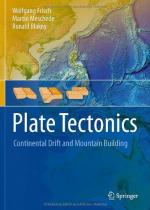|
This section contains 1,875 words (approx. 7 pages at 300 words per page) |

|
The important geologic theory of plate tectonics (tecton - "to build") asserts that the Earth's surface is composed of about seven major blocks, or plates, and many more minor plates that move across the Earth's surface at a very slow rate. Although the plates creep along at just centimeters per year, this movement still causes stress and strain in the Earth's crustal structure. These shifting plates cause faults, mountains, trenches, mid-oceanic ridges and rifts, and even ocean basins Some movements may result in violent earthquakes and volcanic eruptions.
Understanding plate tectonics requires knowledge of the Earth's interior, which can be subdivided based on either structure or composition. The traditional subdivisions of crust, mantle and core are primarily compositional. Subdivision based on structure results in an upper layer known as the lithosphere, that is hard and brittle. It consists of the crust and a small part of...
|
This section contains 1,875 words (approx. 7 pages at 300 words per page) |

|


